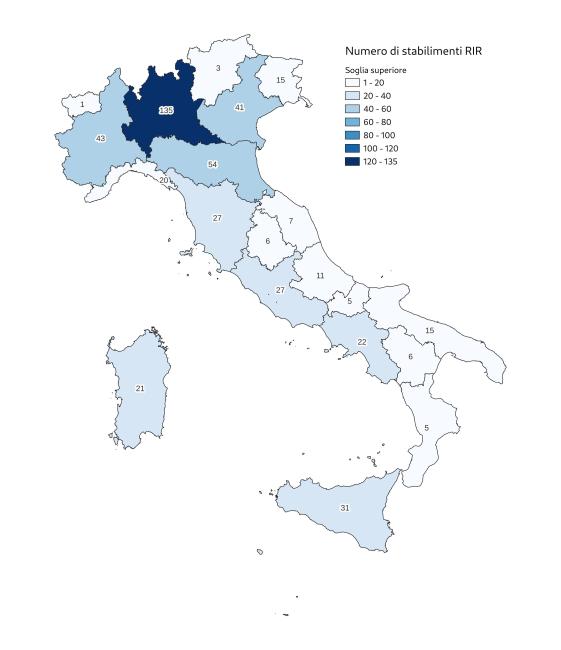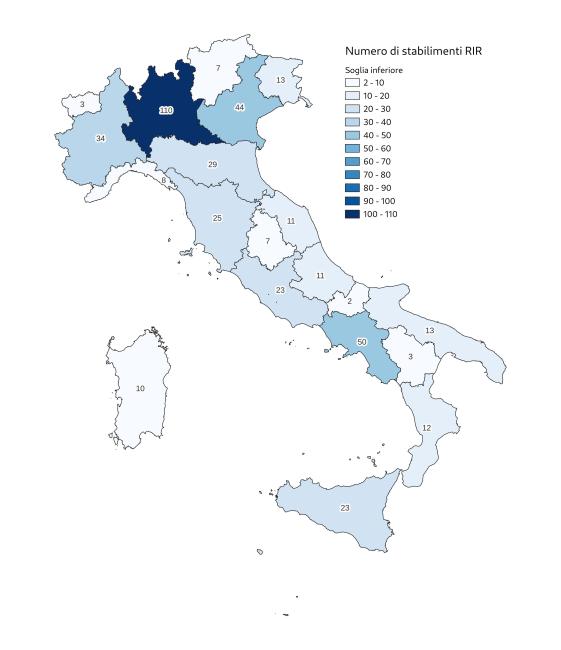Panel 1
Fabrizio Vazzana, Francesca Pepe
The indicator identifies the number of establishments, by regional and provincial level, divided by category, based on the regulatory requirements to which establishment operators are subject. As of June 30, 2025, the total number of establishments considered hazardous for the purposes of a major accident in Italy was 932. Compared to December 2024, when the number of establishments was 933, there has been a reduction (one less). Regarding the distribution of notified establishments across the country, the situation remains virtually unchanged, with approximately a quarter concentrated in Lombardy and in regions with a high industrial presence, such as Veneto, Piedmont, and Emilia-Romagna. Almost all Italian provinces contain at least one establishment at risk of a major accident.
The data available for this indicator are the number of establishments, by regional and provincial scope, divided by category, based on the obligations established by the legislation to which the managers of the establishments are subject. Legislative Decree 26 June 2015, n. 105, in line with the European Directive 2012/18/EU on the control of major-accident hazards connected with the possession of dangerous substances, identifies, based on the nature and quantity of dangerous substances, two different categories of industries with major-accident hazards, associating certain obligations to each of them. In particular, Article 3, paragraph 1 of Legislative Decree 105/15 identifies the following categories of establishments: - “Lower-tier establishment”: an establishment in which the hazardous substances are present in quantities equal to or greater than the quantities listed in column 2 of Part 1 or in column 2 of Part 2 of Annex 1, but in quantities lower than the quantities listed in column 3 of Part 1, or in column 3 of Part 2 of Annex 1, applying, where applicable, the summation rule referred to in note 4 of Annex 1; - “Upper-tier establishment”: an establishment in which hazardous substances are present in quantities equal to or greater than the quantities listed in column 3 of Part 1 or in column 3 of Part 2 of Annex 1, applying, where applicable, the summation rule referred to in note 4 of Annex 1. Managers of establishments that meet these characteristics must comply with specific obligations, including preparing technical and informative documentation, which differs according to the category, in terms of content and recipients. Specifically, it is mandatory to submit to the competent authorities, including ISPRA, the information in the form in Annex 5 of Legislative Decree 105/2015, prepare a “Relevant Accident Prevention Policy Document” and adopt a Safety Management System commensurate with the dangers and complexity of the company and the processes used. The so-called SGS-PIR is mandatory by law, the only case among all the other management systems. For upper-tier establishments, the manager is required to draw up a “Safety Report” to be sent to the competent authority responsible for its assessment (Regional Technical Committees of the Fire Brigade).
To provide an overview of the pressures exerted by establishments at risk of major accidents on the territory.
Preparation of the national inventory of establishments likely to cause major accidents (art. 5, paragraph 3 of Legislative Decree 105/2015).
Panel 2
ISPRA-MASE, Inventario Seveso ISPRA, Annuario dei dati ambientali - Vari anni
None
None
Data quality assessment
All information comes from the National Inventory of establishments likely to cause major accidents, provided for by Article 5, paragraph 3 of Legislative Decree 105/15.
https://www.rischioindustriale.isprambiente.gov.it/seveso-query-105/Default.php
National, Regional, Provincial
2023-2025
Indicator assessment
All information is taken from the National Inventory of establishments likely to cause major accidents, provided for by Article 5, paragraph 3 of Legislative Decree 105/2015. The inventory allows the extraction of an Excel file that allows to extrapolate after different steps, the data necessary for updating the indicator.
As of June 30, 2025, the total number of establishments considered hazardous for the purposes of a major accident, present in Italy, is equal to 932. Compared to December 2024, where the number of establishments was equal to 933, a reduction (1 less) has been recorded.
No significant changes are highlighted, even considering the slight decrease, in the number and type of industries subject to the obligations imposed by the “Seveso” legislation.
Data
Tabella 1-Numero di stabilimenti di soglia superiore e inferiore per provincia
Inventario ISPRA



Table 1, with reference to information updated as of June 30, 2025, summarizes the distribution across the country of establishments subject to Legislative Decree 105/2015, belonging to the various categories (upper and lower threshold) and therefore to the obligations set forth in Articles 13 and 15, divided by province and region. Regarding the distribution across the country of notified establishments, approximately a quarter are concentrated in Lombardy. Regions with a high presence of at-risk industries also include Veneto, Emilia-Romagna, and Piedmont (all in the North and with 8-9% each). Particular concentrations of industries can be noted in areas mostly coinciding with petrochemical (formerly Enichem) and refining hubs such as Trecate (in the Novara area), Porto Marghera, Ferrara and Ravenna in the North, Gela (CL), Augusta-Priolo-Melilli-(Syracuse), and Sarroch (CA). Significant concentrations of industries are also found in industrial areas in the provinces of Milan, Bergamo, Brescia, Naples, Venice, Pavia, Alessandria, and Vicenza. Recently, due to the global economic and industrial crisis, and the petrochemical industry in particular, some of these areas have been partially abandoned or are undergoing industrial transformation (where petroleum chemistry is being replaced by green chemistry). In almost all Italian provinces there is at least one establishment at risk of a major accident, and those with a high number of establishments are: - in the North: Milan (59 establishments), Bergamo (38), Brescia (37), Ravenna (35), Venice (21), Pavia (20), Vicenza (20), Alessandria (20), Turin (19), Novara (19), Udine (19), Lodi (18), Monza and Brianza (17), Varese (17), Bologna (16), Genoa (16), Verona (15), Cremona (13), Padua (12), Ferrara (11), Mantua (10). In the Centre: Rome (18), Frosinone (15), Livorno (13), Latina (10), Florence (10). In the South and Islands: Naples (34), Salerno (17), Syracuse (14), Cagliari (12), Catania (11), Caserta (10).